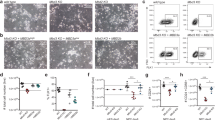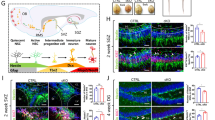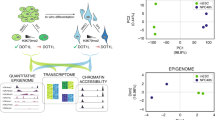Abstract
The repressor element 1-silencing transcription factor (REST) functions as a master regulator to maintain neural stem/progenitor cells (NPCs). REST undergoes proteasomal degradation through β-TrCP-mediated ubiquitylation during neuronal differentiation. However, reciprocal mechanisms that stabilize REST in NPCs are undefined. Here we show that the deubiquitylase HAUSP counterbalances REST ubiquitylation and prevents NPC differentiation. HAUSP expression declines concordantly with REST on neuronal differentiation and reciprocally with β-TrCP levels. HAUSP knockdown in NPCs decreases REST and induces differentiation. In contrast, HAUSP overexpression upregulates REST by overriding β-TrCP-mediated ubiquitylation. A consensus site (310-PYSS-313) in human REST is required for HAUSP-mediated REST deubiquitylation. Furthermore, REST overexpression in NPCs rescues the differentiation phenotype induced by HAUSP knockdown. These data demonstrate that HAUSP stabilizes REST through deubiquitylation and antagonizes β-TrCP in regulating REST at the post-translational level. Thus, HAUSP-mediated deubiquitylation represents a critical regulatory mechanism involved in the maintenance of NPCs.
This is a preview of subscription content, access via your institution
Access options
Subscribe to this journal
Receive 12 print issues and online access
$209.00 per year
only $17.42 per issue
Buy this article
- Purchase on Springer Link
- Instant access to full article PDF
Prices may be subject to local taxes which are calculated during checkout








Similar content being viewed by others
References
Chong, J. A. et al. REST: A mammalian silencer protein that restricts sodium channel gene expression to neurons. Cell 80, 949–957 (1995).
Schoenherr, C. J. & Anderson, D. J. The neuron-restrictive silencer factor (NRSF): a coordinate repressor of multiple neuron-specific genes. Science 267, 1360–1363 (1995).
Ballas, N., Grunseich, C., Lu, D. D., Speh, J. C. & Mandel, G. REST and its corepressors mediate plasticity of neuronal gene chromatin throughout neurogenesis. Cell 121, 645–657 (2005).
Abrajano, J. J. et al. Differential deployment of REST and CoREST promotes glial subtypes specification and oligodendrocyte lineage maturation. PLoS One 4, e7665 (2010).
Westbrook, T. F. et al. SCFβ-TRCP controls oncogenic transformation and neural differentiation through REST degradation. Nature 452, 370–374 (2008).
Guardavaccaro, D. et al. Control of chromosome stability by the β-TrCP-REST-Mad2 axis. Nature 452, 365–369 (2008).
Ballas, N. & Mandel, G. The many faces of REST oversee epigenetic programming of neuronal genes. Curr. Opin. Neurobiol. 15, 500–506 (2005).
Johnson, R. et al. REST regulates distinct transcriptional networks in embryonic and neural stem cells. PLoS Biol. 6, 2205–2219 (2008).
Zuccato, C. et al. Huntingtin interacts with REST/NRSF to modulate the transcription of NRSE-controlled neuronal genes. Nat. Genet. 35, 76–83 (2003).
Lepagnol-Bestel, A. M. et al. Huntingtin interacts with REST/NRSF to modulate the transcription of NRSE-controlled neuronal genes. Hum. Mol. Genet. 18, 1405–1414 (2009).
Tahiliani, M. et al. The histone H3K4 demethylase SMCX links REST target genes to X-linked mental retardation. Nature 447, 601–605 (2007).
Canzonetta, C. et al. DYRK1A-dosage imbalance perturbs NRSF/REST levels, deregulating pluripotency and embryonic stem cell fate in Down syndrome. Am. J. Hum. Genet. 83, 388–400 (2008).
Lawinger, P. et al. The neuronal repressor REST/NRSF is an essential regulator in medulloblastoma cells. Nat. Med. 6, 826–831 (2000).
Su, X. et al. Abnormal expression of REST/NRSF and Myc in neural stem/progenitor cells causes cerebellar tumors by blocking neuronal differentiation. Mol. Cell Biol. 26, 1666–1678 (2006).
Fuller, G. N. et al. Many human medulloblastoma tumors overexpress repressor element-1 silencing transcription (REST)/neuron-restrictive silencer factor, which can be functionally countered by REST-VP16. Mol. Cancer Ther. 4, 343–349 (2005).
Westbrook, T. et al. A genetic screen for candidate tumor suppressors identifies REST. Cell 121, 837–848 (2005).
Holowaty, M. N. et al. Protein profiling with Epstein-Barr nuclear antigen-1 reveals an interaction with the herpesvirus-associated ubiquitin-specific protease HAUSP/USP7. J. Biol. Chem. 278, 29987–29994 (2003).
Boutell, C., Canning, M., Orr, A. & Everett, R. D. Reciprocal activities between herpes simplex virus type 1 regulatory protein ICP0, a ubiquitin E3 ligase, and ubiquitin-specific protease USP7. J. Virol. 79, 12342–12354 (2005).
Andres, M. E. et al. CoREST: a functional corepressor required for regulation of neural-specific gene expression. Proc. Natl Acad. Sci. USA 96, 9873–9878 (1999).
Van der Horst, A. et al. FOXO4 transcriptional activity is regulated by monoubiquitination and USP7/HAUSP. Nat. Cell Biol. 8, 1064–1073 (2006).
Sheng, Y. et al. Molecular recognition of p53 and MDM2 by USP7/HAUSP. Nat. Struct. Mol. Biol. 13, 285–291 (2006).
Saridakis, V. et al. Structure of the p53 binding domain of HAUSP/USP7 bound to Epstein-Barr nuclear antigen 1 implications for EBV-mediated immortalization. Mol. Cell 18, 25–36 (2005).
Li, M., Brooks, C. L., Kon, N. & Gu, W. A dynamic role of HAUSP in the p53-Mdm2 pathway. Mol. Cell 13, 879–886 (2004).
Cummins, J. M. et al. Tumour suppression: disruption of HAUSP gene stabilizes p53. Nature 428, 6982 (2004).
Song, M. S. et al. The deubiquitinylation and localization of PTEN are regulated by a HAUSP-PML network. Nature 455, 813–817 (2008).
Jorgensen, H. F. et al. REST selectively represses a subset of RE1-containing neuronal genes in mouse embryonic stem cells. Development 136, 715–721 (2009).
Chen, Z. F., Paquette, A. J. & Anderson, D. J. NRSF/REST is required in vivo for repression of multiple neuronal target genes during embryogenesis. Nat. Genet. 20, 136–142 (1998).
Singh, S. K., Kagalwala, M. N., Parker-Thornburg, J., Adams, H. & Majumder, S. REST maintains self-renewal and pluripotency of embryonic stem cells. Nature 453, 223–227 (2008).
Buckley, N. J., Johnson, R., Sun, Y. M. & Stanton, L. W. Is REST a regulator of pluripotency? Nature 457, E5–E6 (2009).
Yamada, Y., Aoki, H., Kunisada, T. & Hara, A. Rest promotes the early differentiation of mouse ESCs but is not required for their maintenance. Cell Stem Cell 6, 10–15 (2010).
Zhang, P. et al. Nontelomeric TRF2-REST interaction modulates neuronal gene silencing and fate of tumor and stem cells. Curr. Biol. 18, 1489–1494 (2008).
Bao, S. et al. Cancer stem cells promote radioresistance of malignant glioma through preferential activation of DNA damage checkpoint and repair. Nature 444, 756–760 (2006).
Bao, S. et al. Targeting cancer stem cells through L1CAM suppresses glioma growth. Cancer Res. 68, 6043–6048 (2008).
Li, Z. et al. Hypoxia-inducible factors regulate tumorigenic capacity of glioma stem cells. Cancer Cell 15, 501–513 (2009).
Acknowledgements
We thank members in the J.N.R. lab for helpful discussions and suggestions. We are also grateful to the Flow Cytometry Core, Imaging Core and Central Cell Services at Cleveland Clinic Lerner Research Institute for their help and services. This work was supported by a research fund from Cleveland Clinic Foundation and a NIH grant (NS070315) to S.B.
Author information
Authors and Affiliations
Contributions
Z.H., Q.W., O.A.G. and L.C. carried out and planned all experiments. S.B. developed the hypothesis, coordinated the study, oversaw the research and results, and wrote the manuscript. J.N.R. helped to write the manuscript and provided input into design and interpretation. W.S. provided reagents and helpful suggestions. The work was carried out in the laboratory of S.B.
Corresponding author
Ethics declarations
Competing interests
The authors declare no competing financial interests.
Supplementary information
Supplementary Information
Supplementary Information (PDF 1969 kb)
Rights and permissions
About this article
Cite this article
Huang, Z., Wu, Q., Guryanova, O. et al. Deubiquitylase HAUSP stabilizes REST and promotes maintenance of neural progenitor cells. Nat Cell Biol 13, 142–152 (2011). https://doi.org/10.1038/ncb2153
Received:
Accepted:
Published:
Issue Date:
DOI: https://doi.org/10.1038/ncb2153
This article is cited by
-
CRISPR/Cas9-based genome-wide screening of the deubiquitinase subfamily identifies USP3 as a protein stabilizer of REST blocking neuronal differentiation and promotes neuroblastoma tumorigenesis
Journal of Experimental & Clinical Cancer Research (2023)
-
Resequencing of the TMF-1 (TATA Element Modulatory Factor) regulated protein (TRNP1) gene in domestic and wild canids
Canine Medicine and Genetics (2023)
-
Targeting ubiquitin specific proteases (USPs) in cancer immunotherapy: from basic research to preclinical application
Journal of Experimental & Clinical Cancer Research (2023)
-
Angiotensin-converting enzyme inhibitor promotes angiogenesis through Sp1/Sp3-mediated inhibition of notch signaling in male mice
Nature Communications (2023)
-
The deubiquitinase USP7 promotes HNSCC progression via deubiquitinating and stabilizing TAZ
Cell Death & Disease (2022)



